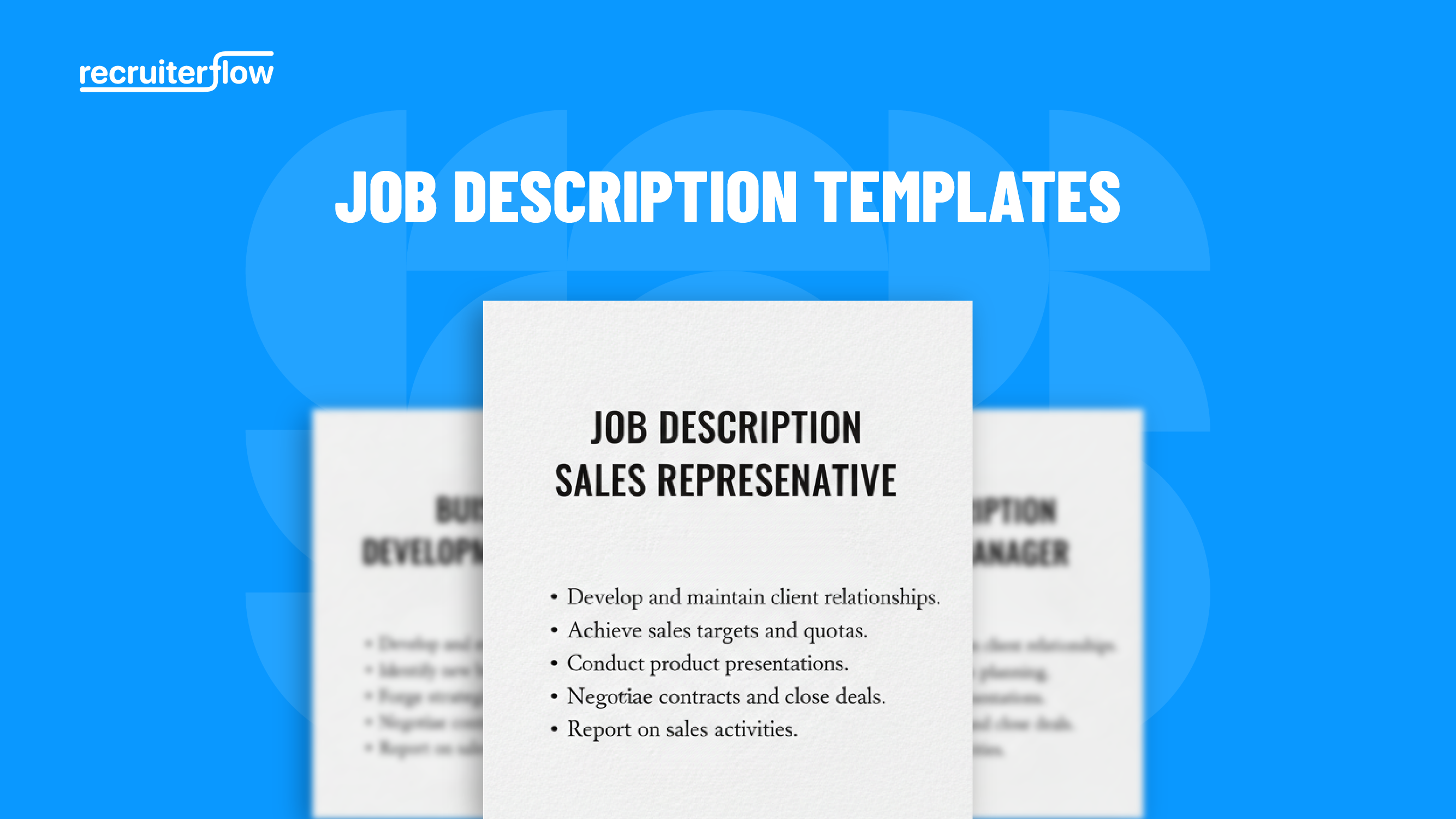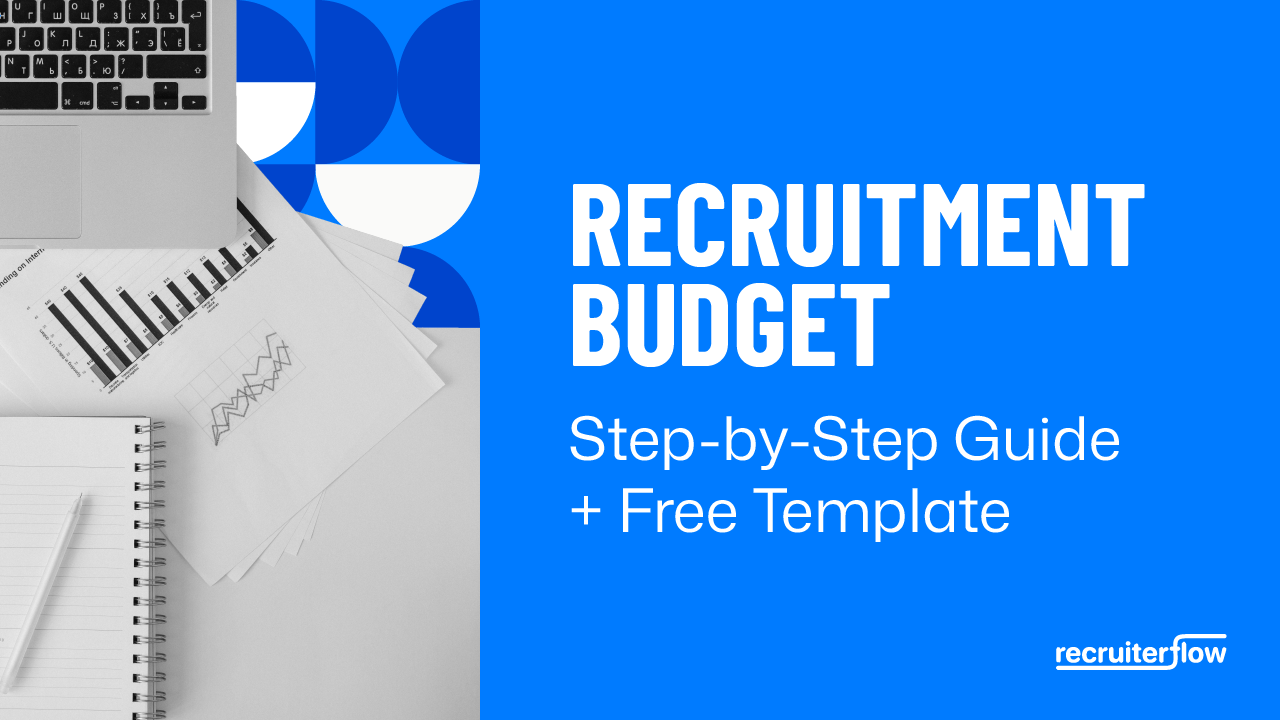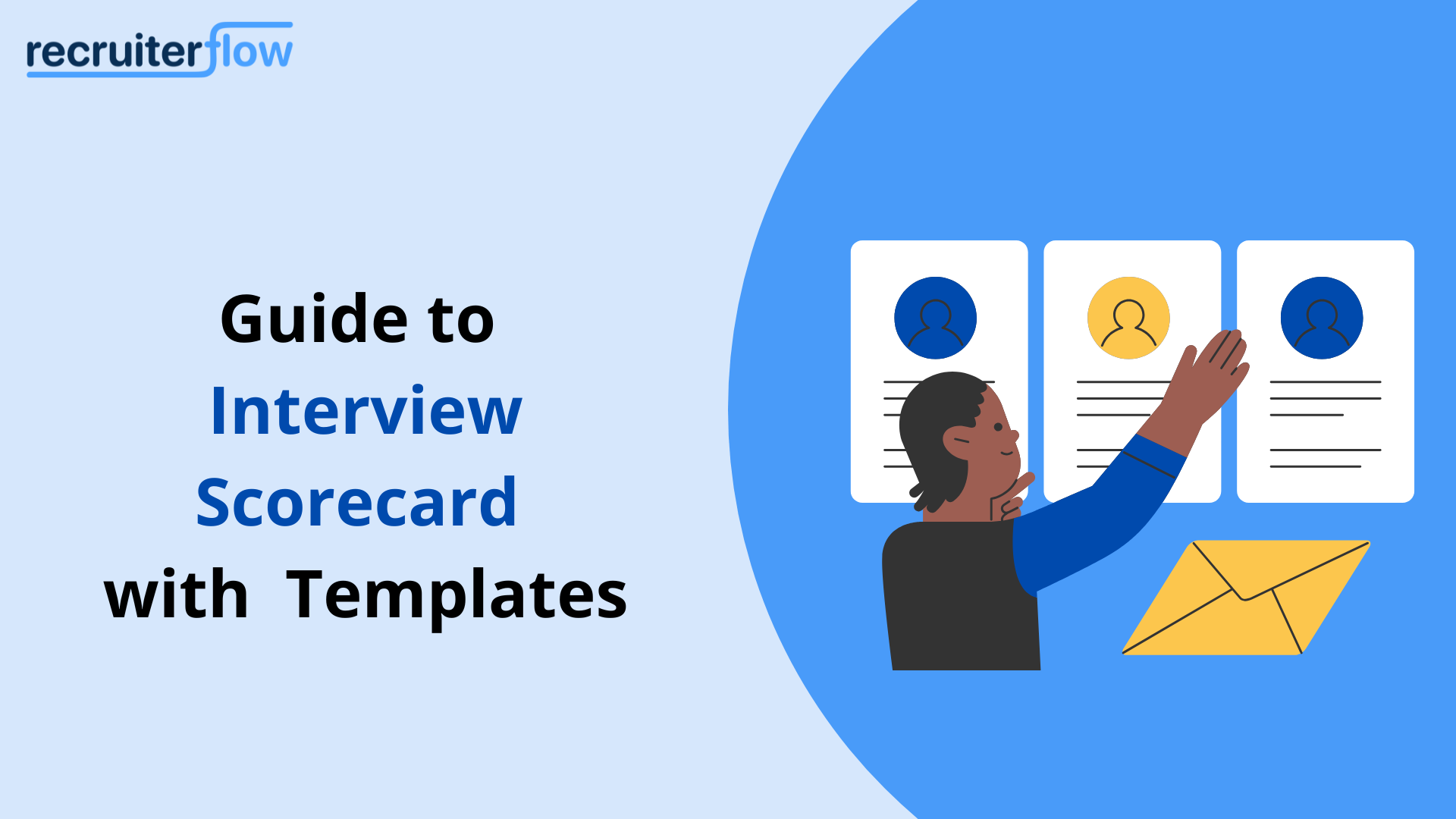
Recruitment Budget 2026: Step-by-Step Guide + Free Template

There’s a massive leak in the revenue engines of most recruitment agencies and they aren’t even aware of it. Here’s a quick fact check:
- In 2025, companies are dedicating over 40% of their HR budgets to talent acquisition. Yet many still lack a coherent plan for measuring ROI.
- Unfilled roles cost organizations an average of $500 per day in lost productivity.
Pouring more money isn’t the solution. If anything, it will be a deterrent to growth. Creating a robust recruitment budget is key to scale.
This guide walks you through every step of building an effective recruitment budget for 2026 one that aligns with your goals and drives measurable ROI. You’ll learn how to base your budget on data, flexibility, and transparency, ensuring every dollar spent supports sustainable growth. Use our free template, explore real-world examples, and apply practical tactics to help your recruitment business scale efficiently and profitably.
Bonus: We’ll be drawing insights from Greg Savage’s compensation framework for agencies.
What Is a Recruitment Budget?
A recruitment budget acts as the financial GPS to guide every recruitment decision made by an agency. It forecasts and impacts everything from sourcing and technology to recruiter compensation and candidate experience. It breaks down where to spend, where to save, and where to double down for sustainable, profitable growth.
The ideal recruitment budget turns financial planning into a forecasting tool, balancing short-term client needs with long-term growth. Modern day recruitment budgets must include:
- Cost-per-hire
- Recruiter productivity ratio (Gross Profit ÷ Total Pay)
- Source-of-hire ROI
- Technology ROI per seat
Pro-Tip: Your recruitment budget should reflect your agency’s priorities. For example, if 40% of your spend goes toward sourcing tools but only 5% to recruiter training, you’re enabling recruiters with tools without the training to use them effectively.
Read More: 360 Recruitment: A Complete Guide for 2025
Why a Recruitment Budget Matters for Recruitment Agencies
Recruitment budgets, at their best, are growth levers, not expenses.
A precise budget doesn’t just cut costs. It channels investments into areas driving the highest ROI. If you’re asking, “Why is a recruitment budget important?”, here’s the answer:
Data-Driven Decision Making
Budgets highlight which sourcing channels deliver the best hires or which tools waste money. This is especially true for managing recruiter compensation.
“Recruiters account for the most significant expense for any recruitment agency. Indeed, most recruitment companies will find that staff salaries, mostly recruiters, absorb 50% to 60% of their Gross Profit. So, it’s only logical to assess the investment.” – Greg Savage
Profit Protection
A structured budget helps you manage compensation strategically, using metrics like:
| Metric | Formula | Purpose |
| Gross Profit per Staff | Total GP ÷ Total Headcount | Overall productivity |
| Gross Profit per Biller Salary | GP ÷ Salary | Compensation leverage (target 2.5–3x) |
| Cost per Seat | (Total Expenses – Recruiter Salaries) ÷ Billers | Breakeven per recruiter |
Track these indicators regularly, and you’ll ensure that every hire, bonus, and tech subscription contributes directly to business growth.
Bonus: Recruitment strategies for when budgets and tight
- Double down on non-monetary perks. If you cannot keep offering bonuses, offer better career growth, work flexibility, remote work, and improvements in work culture.
- Lean out your tech stack. Keep only essential tools and avoid feature overlap. Pick end-to-end hiring tools like Recruiterflow, providing 360-degree hiring solutions.
- Rely more on referrals & alumni networks. Cut down on active searches via paid job sites. These are low-cost funnel sources.
- Focus on generating valuable content & building relationships. This contributes to passive candidate nurturing, and makes candidates come to you (or respond positively when your recruiters reach out.)
How Budget Shapes Recruitment and Selection
Budgets dictate your recruiting architecture: where you look for candidates/clients, how fast you can hire, what client experience you deliver, and the margins you keep.
Mapping Budget to Strategy
| Budget Tier | Primary Bet | Channels | Core KPIs to Track |
| Lean | Network effects & precision | Referrals, alumni, organic LinkedIn, niche boards | Time-to-fill (TTF), source quality %, referral rate, offer acceptance |
| Moderate | Balanced pipeline + ops efficiency | Targeted job boards, selective paid social/search, essential ATS/CRM automation | TTF, cost-per-hire (CPH), stage-to-stage conversion, scheduler/automation saves |
| Generous | Speed, reach & brand equity | Multi-market ads, programmatic/job distribution, brand campaigns, rich tech stack | TTF by role, quality-of-hire, candidate NPS, brand lift, recruiter productivity |
Median time-to-fill stays generally around 41–43 days in recent cycles. More paid media and automation maturity lead to faster fills, but agencies must keep eliminating underperforming channels.
Budget tells your team what “wins”
If 45–50% of your budget goes to tools, you’re aiming for scale via automation. If 20–30% goes to employer branding and candidate experience, you’re focusing on long-term conversion and pricing power. Budgets impact recruiter behavior and candidate experience.
Poor experiences lower acceptance rates. Positive ones increase them. 66% say it influences acceptance. Negative experiences result in measurable revenue loss via “candidate resentment.”CareerPlug+1
Budgets predict productive expenditure
Every open seat has an opportunity cost, the amount it makes sense to spend to fill it. Here’s a simple sanity check:
Cost of Vacancy per day = (Annual revenue impact of role ÷ 220 workdays).
Pro-Tip: Bring compensation math into the budget.
- Aim for GP ÷ total pay in the 2.0–2.5x “healthy” zone; 2.5x+ is “optimal.”
- Track GP per income-producer salary (target 2.5–3x).
- If budgets are slipping while you add tools or ads, rebalance. Go back to the drawing board.
- Put limits on your Cost per Seat (overhead per recruiter excluding salary). This helps you set a real break-even point and decide when to spend more.
Example: If Cost-per-Seat is $100k and base is $100k, a recruiter must generate $200k GP just to break even—so your “generous” budget mode should be tied to roles or clients that return far above that GP.
- Lean budgets = protect margin, accept slower role fills.
- Moderate budgets = test & reallocate monthly.
- Generous budgets = buy more only when vacancy cost + GP potential beats incremental media/assessment spend.
How to Build a Recruitment Budget That Works Step-by-Step
Download the Recruiterflow Compensation Ebook and start building a smarter 2026 recruitment budget today.
Pro-Tip: Create a budget that can be audited monthly and reallocated in days, rather than just once a year.
Step 1: Quantify last year with 6 metrics
Pull these data points across roles/clients/sources:
- Time to fill (TTF) by role
- Cost per hire (CPH)
- Source efficiency (source-to-hire conversion and acceptance rate per source)
- Offer acceptance
- Recruiter productivity/compensation leverage
Example (with assumed numbers):
| Metric | Tech Roles (Avg) | Finance Roles (Avg) | Healthcare Roles (Avg) | Benchmarks / Insights |
| Time to Fill (TTF) | 38 days | 46 days | 54 days | Global avg = 44 days (longer for regulated sectors) |
| Source Efficiency (% of hires / applicants) | Referrals 12%
LinkedIn 8% Job Boards 4% |
Referrals 15%
|
Referrals 9% • Agencies 5% | Referrals usually more efficient than paid sources |
| Candidate Experience (Offer Accept %) | 78% | 72% | 69% | Positive candidate journeys raise acceptance rates by |
| Recruiter Productivity / Comp Leverage | $280 k GP per recruiter / $110 k comp = 2.55× | $310 k GP / $135 k = 2.30× | $295 k GP / $150 k = 1.97× | Healthy = 2.0–2.5×
Optimal = 2.5× |
Step 2: Forecast demand and vacancy cost
Calculate the Cost of Vacancy (CoV) so you know when to spend more.
- CoV/day = (Annual revenue generated by the role) ÷ 220 workdays
For example, let’s say that CoV/day is > $300–$500. In that case, you can green-light extra spend (ads, sourcer time, assessments) in order to cut 1–2 weeks from time-to-fill.
Step 3: Balance fixed vs. variable costs
- Fixed costs: ATS/CRM, essential licenses, baseline careers pages, and media.
- Variable costs: programmatic/job distribution, paid social/search bursts, niche boards, and talent communities.
Step 4: Allocate budget by role tier
Don’t set your budget once and hope it holds up to all pressures. Hiring doesn’t follow a calendar. Demand spikes, key people quit, and priorities change overnight.
Allocate funds according to role, and guard these limits with automatic “tripwires”: signs to indicate when to change investment in a specific role.
Not every job deserves the same amount of time, effort, or money.
Hiring a VP of Sales will directly impact revenue. It deserves a larger budget than filling three entry-level support roles.
We recommend following a tier-based approach to allocating budgets, like this:
| Tier | Type of Role | Budge | When to Use It |
| High Impact | Senior, revenue-driving, or hard-to-fill roles (engineers, sales execs, nurses) | Generous | When the role has a big business impact or high cost of vacancy |
| Core Roles | Mid-level positions that keep Ops running (recruiters, analysts, account managers) | Moderate | When roles are important but easier to fill |
| Volume Roles | Entry-level or evergreen positions ( support, customer service) | Lean | When roles are repeatable and easier to fill |
Step 5: Fund experience & skills
Most recruitment budgets focus on getting more applicants by spending on ads, job boards, and paid campaigns. What’s smarter is to invest in two key factors that cost much less: improved candidate experience and a skills-first hiring approach. Recruiters who search by skills instead of titles see 24% higher InMail acceptance rates.
Pro-Tip: Set aside $500–$1,000 per recruiter each year for micro-learning or tools that teach smarter sourcing.
- Invest in Candidate Experience: 58% of job seekers decline offers because of a poor hiring experience. Every candidate interaction (application, interview, follow-up) is part of your marketing. If candidates are satisfied, they are more likely to say yes to offers. 80% say they’d reapply or refer others after a positive one — even if they didn’t get the job.
A quick summary:
| Small Investment | What It Does | Why It’s Worth It |
| Scheduling tools (Calendly, GoodTime, etc.) | Let candidates book interviews instantly | Cuts ghosting, speeds up hiring |
| Interview training for hiring managers | Teaches consistent, respectful candidate treatment | Raises offer-accept rates |
| Automated “thank you” + status updates | Keeps candidates informed | Reduces drop-off and resentment |
| Post-interview surveys | Collect quick feedback | Highlights process gaps before they hurt your brand |
Step 8: Document your budget in a single view
Put everything in a single, organized document for the record. Here’s an example:
| Signal | Action | Why |
| CPH > target for 2 weeks | Cut bottom-two sources; move 15% to top performer; add skill-first search block | Programmatic case studies show big gains from reallocation. |
| TTF rising; CoV/day > $300 | Approve 14-day burst | Speed premium usually beats vacancy cost over a week. |
| Acceptance < 60% | Fund interview ops (SLAs, reminders); hiring manager coaching | Acceptance is highly experience-sensitive. |
| GP ÷ total comp < 2.0x | Freeze non-essential tools; raise commission threshold to seat+base | Protects margin and aligns pay with performance. |
Also read: 14 Recruitment Strategies to Attract Best Talent in 2025
Recruitment Budget Example for Agencies
Here’s the formula to calculate the recruitment budget.
Recruitment Budget = (Planned Hires × Avg. Cost-per-Hire) + (Recruiter Compensation/ Tech Stack & Tools/ Employer Branding/ Candidate Experience)
Set Annual Goals & Revenue Targets
| Goal Type | Input |
| Annual Revenue Target | $4.2M |
| Planned Hires | 10 recruiters |
| Avg. GP (Gross Profit) per Recruiter | $300K |
| Target GP ÷ Compensation Ratio | 2.5× |
| Avg. Cost per Seat (non-salary overhead) | $100K |
Track Six Core Metrics Monthly
| Metric | Formula | Healthy Range | Why It Matters |
| Gross Profit per Staff Member | GP ÷ Headcount | Rising with scale | Measures productivity per team member |
| GP per Recruiter (Biller) | GP ÷ No. of Recruiters | $250K–$400K | Shows recruiter output |
| GP ÷ Recruiter Salary | GP ÷ Total Salary | 2.5×+ | Indicates compensation leverage |
| GP ÷ Total Compensation | GP ÷ (All pay + bonuses) | 2.0–2.5× | Overall business health |
| Cost per Seat | (Total Expenses – Salaries) ÷ Recruiters | $80K–$120K | True overhead per recruiter |
| Time to Fill (TTF) | Days from req to offer | Role-specific | Speed of execution |
Keep a checklist for quarterly reviews
Ask these questions when examining metrics every three months:
- Has GP ÷ Comp stayed above 2.0×?
- Is the average TTF improving?
- Are we overspending on low-tier roles?
- Are top performers rewarded fairly?
- Have we funded recruiter training?
Recruitment Budget Template (Free Download)
If you’re starting on your first recruitment budget, consider trying this template and expanding on it based on your agency’s requirements and limits.
FREE Download: Recruitment Budget Template by Recruiterflow
NOTE: This template is a sample. The numbers will change based on your requirements. It is designed to serve as a reference point.
Common Mistakes Agencies Make in Recruitment Budgeting
The top-performing firms are quick to address these issues in their recruitment budgets, especially when starting out.
Ignoring the actual cost per seat
Agencies almost inevitably underestimate the cost it actually takes to fill a role. They might only be thinking of the job boards and recruiter hours, but forget to account for the ramp time, disappearing candidates, and lost opportunities.
For instance, replacing a regional sales manager costs $80,960 across 22 weeks and 172 hours of lost productivity.
Creating annual budgets and not updating them
Hiring demands change every quarter, clients pause contracts, and new roles open. An annual budget will not be able to keep up with these shifts effectively.
Static budgets fail by creating overspending and underspending within one year, as funds cannot be reallocated dynamically. Slow months = overspending, demand spikes = team starves for funds.
Not distinguishing between role tiers
Budgeting evenly across all roles almost guarantees ROI loss. Every role does not contribute to the same, nor does every vacancy incur the same cost of delay.
A senior software engineer will probably cost $1,000+ per day in lost revenue opportunity. For a junior support role, that might dip down to $150 per day.
Not budgeting for candidate experience
No matter how much recruiting agencies spend to drive applicants to the table, poor experiences will frustrate them. Nothing can compensate for slow replies, ghosting, and unclear next steps.
Recruiters who personalize outreach by skills and maintain consistent follow-up see 24% higher acceptance rates.
Recruiterflow lets you implement many smart, low-cost experience investments:
- Scheduling automation
- Post-interview thank-you sequences
- Feedback SLAs (24–48h rule)
These simple steps can go a long way to improve acceptance rates and reduce the need for expensive paid media to fill roles.
Not mapping recruiter compensation to profitability
Paying recruiter commissions on gross revenue or billings instead of gross profit is a cardinal mistake. It effectively rewards recruiters for expensive placements that eventually shrink profit margins.
Budgeting in silos
No budget can stand on its feet if its ownership is in silos. In that case, finance teams will focus on numbers, recruiters focus on hiring speed, and higher leadership insists on growth.
In the absence of collaboration, the same funds get hijacked for completely different purposes. Without cross-functional planning, the same dollar gets promised three different ways.
How Recruiterflow helps you build an optimal recruitment budget
The best recruitment budgets cut costs, control performance, and point out the most profitable avenues to invest in. Recruiterflow helps with building such budgets by unifying scattered data, which helps derive insights to drive predictable, profitable growth.
Here’s how:
- Tracks cost-per-hire, source performance, and recruiter GP in one dashboard.
- The Compensation Ebook model helps maintain a healthy GP ÷ total comp ratio and reward results, not just recruiter activity.
- Highlight which roles and recruiters are yielding the best results.
- Highlights data that helps spot overspending, track recruiter output, and adjust budgets monthly.
- Carries built-in communication tools and analytics to improve candidate experience.
We’re not just talking about a big game. Sign up for a demo, and let us show you how Recruiterflow turns your budget into a performance engine.
FAQs related to recruitment Budget
What is included in a recruitment budget?
A recruitment budget includes all costs related to hiring, covering everything from job advertising, recruiter pay, tools and technology, candidate experience, and employer branding.
Examples of recruitment budget variables:
- Job boards, social media ads, sponsored listings.
- Salaries, commissions, bonuses, and benefits.
- ATS, CRM, sourcing tools, automation software.
- Assessments, travel, relocation, background checks.
- Website, content, events, design, campaigns.
- Office space, insurance, admin, and accounting.
The strongest budgets also consider“soft costs” like recruiter time, lost productivity, and training.
How often should recruitment budgets be reviewed?
Recruitment budgets should be reviewed quarterly. It is ideal to:
- Re-forecast expenses based on performance metrics like cost-per-hire (CPH), time-to-fill (TTF), and recruiter productivity.
- Track variances and reallocate spend toward top-performing sources.
- Rework strategic goals and compensation ratios.
What is the average recruitment budget per hire?
If you’re in the USA, your average recruitment budget per hire will probably hover around $4,700 to $5,475.
- The Society for Human Resource Management (SHRM) reports the average cost-per-hire for non-executive positions in the U.S. is $5,475, and for executive roles about $35,879.
- Other publications cite an average around $4,700 for typical roles. Technical/specialist positions often cost significantly more ($6,000+). Engagedly+2Truffle+2
Can agencies use the same recruitment budget template for all clients?
Absolutely not. Agencies must customize recruitment budgets according to client type or role tier. Using one generic template is a sure way to overspending/underspending and lost opportunities.
Different clients have different hiring volumes, urgency levels, and cost-per-hire benchmarks. Any “one-size-fits-all” budget will cover up inefficiencies and misallocate funds.
It’s best to use tiered budgets (strategic, core, volume) designed to allocate funds based on role impact and difficulty.
Recruitment





Abhishek Sharma